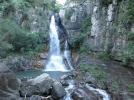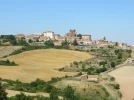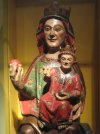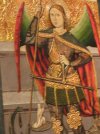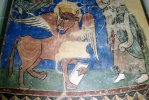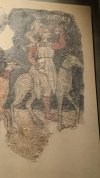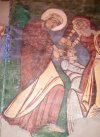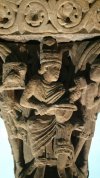I don't think it's necessary to do a minutia-laden description since you can get plenty of information on the web. Mundicamino, gronze, and the Eroski site all have a lot of detail. But since I'm compiling all my gps tracks, my journal notes, and my blog, I may as well just do another day by day. Maybe it will encourage some of you to sample this beautiful and varied walk.
Day 1 -- Somport to Canfranc Estación (8 km)
LTfit and I came over to the Aragonés via San Juan de la Peña and the Camino Aragonés. My description of the previous days from Montserrat to San Juan and down to the Aragonés at Santa Cilia is here.
We arrived at Santa Cilia at around 10 in the morning, having left our albergue in Botaya around 6 am and gone up to San Juan again. Because of our previous day's visit we were able to just walk by. Our plan was to backtrack to the Spanish border at Puerto de Somport, so we could walk all of the Camino Aragonés, at least all that is on the Spanish side of the border. There was no bus till late afternoon, and the thought of an entire day spent sitting in the small (though very friendly) town of Santa Cilia had no appeal. So we stuck our thumbs out on the highway, trying to hitch a ride. No luck, but we did give up after only about 5 minutes. We then walked off the highway onto the connector road between the town and the highway, and just flagged down the first car going by. It's amazing what the difference in speed will do. People who see you and are going slow will frequently stop (I have flagged down rides on different caminos this way, in Lugo to get to Santa Eulalia, on the Vadiniense to get back to Potes from the monastery, etc.). This was no exception. The first car to pass promptly stopped and invited us into the car. He was only going as far as Jaca, but volunteered to take us the additional 30 some kms up to Somport. Camino angel!!!!!


There is an albergue in Somport, which also has a bar/restaurant down below, but nothing else. All was closed when we arrived around noon. So we decided to start out from the pass and head down to Canfranc Estación, which would take a nice chunk out of the next day's walk to Jaca. We took a long rest on a bench, just soaking in the incredible mountain beauty, and then we headed off, on a steady descent to Canfranc Estación. After just having struggled with the horrible, steep, rocky descent from San Juan to Santa Cruz de la Serós, this was a piece of cake. The weather was beautiful, the views were incredible, and we arrived in Canfranc with plenty of time to shower and wash before finding a place to eat lunch.


There are two albergues in Canfranc Estación. The first one you come to (Albergue Pepe Grillo) is not as highly recommended as the second one (Albergue Río Aragón), but the second one was closed. We spent the night in Pepe Grillo and it was just fine, has a nice bar on the first floor and the owners are quite friendly. I think our room had three bunk beds, and it wasn't at all crowded.
Canfranc Estación is an enormous train station that was opened in the early 1900s and was envisioned as the main route to France. An accident on the French side ruined the tracks, and the French decided not to rebuild, in the 1970s. That left this white elephant station with no purpose in life, other than a few little local trains, which still are running. Adif operates tours of the big building, which is otherwise closed, but we missed the afternoon tour because we were stuffing our bellies. We did, however, have plenty of time to wander around the station and peek through a few windows. I would love to go back and take the tour. There are many plaques recounting pieces of the station's history, and one of the most interesting tidbits was the discovery, about 15 years ago, of a stash of papers. Apparently, a French taxi driver who loves old trains, found a way into the station (the owner of a store nearby said that as kids, they loved going into the station and playing around, all highly prohibited of course). He discovered a huge pile of papers that indicated that Franco had used the station during WWII to facilitate Germany's "export" of huge amounts of stolen gold. On the return trip, raw materials for materiel were sent back to Germany. These papers have been the source of a couple of books, El Oro de Canfranc and Canfranc el Mito, both of which I would have bought but for the fact that I was walking.

In any event, if you are lucky enough to take the tour, let us know what you saw and how it was. And let me also say by way of encouragement that the marking is excellent and we navigated this camino with no guide, just an occasional reference to the online sources. Buen camino, Laurie
Day 1 -- Somport to Canfranc Estación (8 km)
LTfit and I came over to the Aragonés via San Juan de la Peña and the Camino Aragonés. My description of the previous days from Montserrat to San Juan and down to the Aragonés at Santa Cilia is here.
We arrived at Santa Cilia at around 10 in the morning, having left our albergue in Botaya around 6 am and gone up to San Juan again. Because of our previous day's visit we were able to just walk by. Our plan was to backtrack to the Spanish border at Puerto de Somport, so we could walk all of the Camino Aragonés, at least all that is on the Spanish side of the border. There was no bus till late afternoon, and the thought of an entire day spent sitting in the small (though very friendly) town of Santa Cilia had no appeal. So we stuck our thumbs out on the highway, trying to hitch a ride. No luck, but we did give up after only about 5 minutes. We then walked off the highway onto the connector road between the town and the highway, and just flagged down the first car going by. It's amazing what the difference in speed will do. People who see you and are going slow will frequently stop (I have flagged down rides on different caminos this way, in Lugo to get to Santa Eulalia, on the Vadiniense to get back to Potes from the monastery, etc.). This was no exception. The first car to pass promptly stopped and invited us into the car. He was only going as far as Jaca, but volunteered to take us the additional 30 some kms up to Somport. Camino angel!!!!!


There is an albergue in Somport, which also has a bar/restaurant down below, but nothing else. All was closed when we arrived around noon. So we decided to start out from the pass and head down to Canfranc Estación, which would take a nice chunk out of the next day's walk to Jaca. We took a long rest on a bench, just soaking in the incredible mountain beauty, and then we headed off, on a steady descent to Canfranc Estación. After just having struggled with the horrible, steep, rocky descent from San Juan to Santa Cruz de la Serós, this was a piece of cake. The weather was beautiful, the views were incredible, and we arrived in Canfranc with plenty of time to shower and wash before finding a place to eat lunch.


There are two albergues in Canfranc Estación. The first one you come to (Albergue Pepe Grillo) is not as highly recommended as the second one (Albergue Río Aragón), but the second one was closed. We spent the night in Pepe Grillo and it was just fine, has a nice bar on the first floor and the owners are quite friendly. I think our room had three bunk beds, and it wasn't at all crowded.
Canfranc Estación is an enormous train station that was opened in the early 1900s and was envisioned as the main route to France. An accident on the French side ruined the tracks, and the French decided not to rebuild, in the 1970s. That left this white elephant station with no purpose in life, other than a few little local trains, which still are running. Adif operates tours of the big building, which is otherwise closed, but we missed the afternoon tour because we were stuffing our bellies. We did, however, have plenty of time to wander around the station and peek through a few windows. I would love to go back and take the tour. There are many plaques recounting pieces of the station's history, and one of the most interesting tidbits was the discovery, about 15 years ago, of a stash of papers. Apparently, a French taxi driver who loves old trains, found a way into the station (the owner of a store nearby said that as kids, they loved going into the station and playing around, all highly prohibited of course). He discovered a huge pile of papers that indicated that Franco had used the station during WWII to facilitate Germany's "export" of huge amounts of stolen gold. On the return trip, raw materials for materiel were sent back to Germany. These papers have been the source of a couple of books, El Oro de Canfranc and Canfranc el Mito, both of which I would have bought but for the fact that I was walking.

In any event, if you are lucky enough to take the tour, let us know what you saw and how it was. And let me also say by way of encouragement that the marking is excellent and we navigated this camino with no guide, just an occasional reference to the online sources. Buen camino, Laurie





